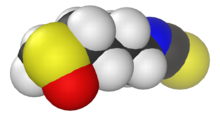
Sulforaphane

| |

| |

| |
| Names | |
|---|---|
|
Preferred IUPAC name
1-Isothiocyanato-4-(methanesulfinyl)butane | |
| Identifiers | |
|
3D model (JSmol)
|
|
| ChEBI | |
| ChEMBL | |
| ChemSpider |
|
|
PubChem CID
|
|
| UNII | |
|
CompTox Dashboard (EPA)
|
|
| |
| |
| Properties | |
| C6H11NOS2 | |
| Molar mass | 177.29 g/mol |
|
Except where otherwise noted, data are given for materials in their standard state (at 25 °C [77 °F], 100 kPa).
| |
Sulforaphane (sometimes sulphoraphane in British English) is a compound within the isothiocyanate group of organosulfur compounds. It is produced when the enzyme myrosinase transforms glucoraphanin, a glucosinolate, into sulforaphane upon damage to the plant (such as from chewing or chopping during food preparation), which allows the two compounds to mix and react.
Sulforaphane is present in cruciferous vegetables, such as broccoli, Brussels sprouts, and cabbage.
Sulforaphane (SFN) has two possible stereoisomers due to the presence of a stereogenic Sulfur atom.
The R-SFN enantiomer occurs naturally, while the S-SFN can be synthesized.
 Glucoraphanin, the glucosinolate precursor to sulforaphane |
Occurrence and isolation
Sulforaphane occurs in broccoli sprouts, which, among cruciferous vegetables, have the highest concentration of glucoraphanin, the precursor to sulforaphane. It is also found in cabbage, cauliflower, Brussels sprouts, bok choy, kale, collards, mustard greens, and watercress.
Research
Studies in vitro demonstrate that SFN regulate actin cytoskeleton, inhibiting the formation of actin stress fiber and the expression of associated proteins which promotes the spread of premalignant cells. Therefore, the study shown that SFN suppresses metastasis of breast cancer.
Although there has been some basic research on how sulforaphane might have effects in vivo, there is no clinical evidence that consuming cruciferous vegetables and sulforaphane affects the risk of cancer or any other disease, as of 2017.
See also
|
Cruciferous biochemistry
| |
|---|---|
| Types of compounds | |
| Glucosinolates | |
| Isothiocyanates (ITC, mustard oils) |
|
| Bioactive metabolites | |